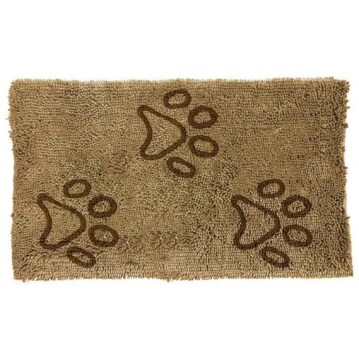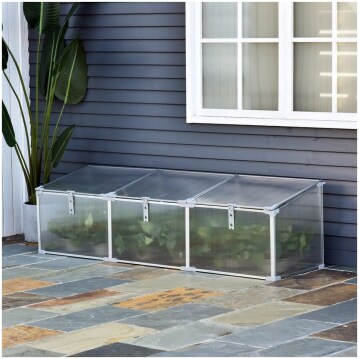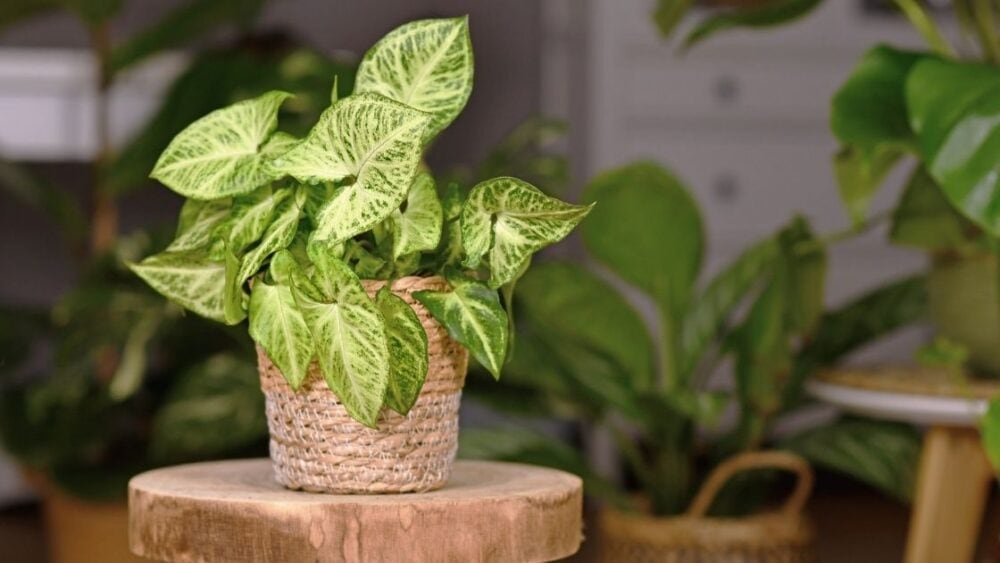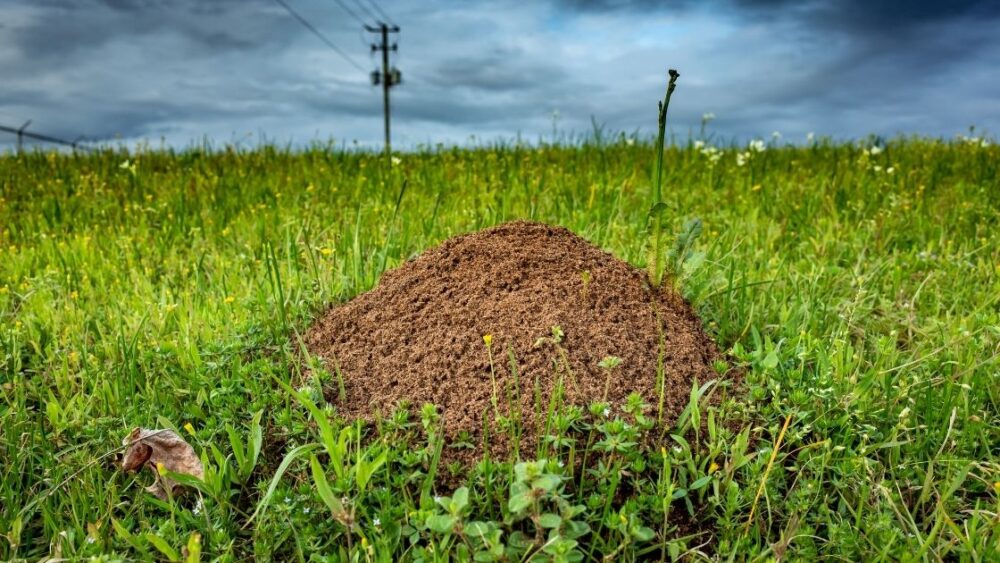
Are you suspecting that your yard might be infested by pocket gophers or do you want to save your garden from these troublesome rodents? If yes, then this write-up can play the role of a perfect manual for you. Read on to know more.
What are pocket gophers?
Pocket gophers (aka gophers) are burrowing rodents found in various parts of the Western Hemisphere. They are called so because of their fur-lined cheek pouches or pockets.
To date, scientists have identified around 13 species of these rodents in the United States. Each of these species has certain features in common. They are:
Browse our Affiliate Products
- Their length varies between 5 and 14 inches
- Their weight varies between 6 ounces and 2 pounds
- The color of their fur is either white or light brown or black
- They possess remarkably small eyes and ears and rely mainly on the sense of touch, which makes skin their primary sense organ
- They are characterized by a tiny, flattened head, short neck, and long claws
- They are isolated creatures and thus usually just one gopher attacks a yard at a time
How do Gophers get onto properties?
Pocket gophers are four-legged mammals who spend almost their entire lives underground. They move through a network of burrows and tunnels to gather food and completing most activities of their daily life. According to experts, the tunnel system of these rodents can extend up to 200 yards and each tunnel system can have as many as 100 mounds.
Gofers dig the tunnels using their long claws and sharp teeth. They loosen the soil using these natural weapons and carry it out of the tunnels. This results in the formation of visible mounds all across our yard. One adult gopher is capable of moving more than 1-ton soil per year and is responsible for the formation of hundreds of mounds in yards infested by them.
When the gofers retreat inside, they make sure that the mounds are duly plugged. This allows them to remain protected from snakes and other predators.
What are the signs if you have a gopher problem?
Your yard is most likely infested by a gopher if the mounds appear to be horseshoe or crescent-shaped when seen from above. Also, the arms of those crescents will have plugs of dirt in between them. The section below will educate you more about the typical signs of a gopher problem.
1. What are gopher mounds?
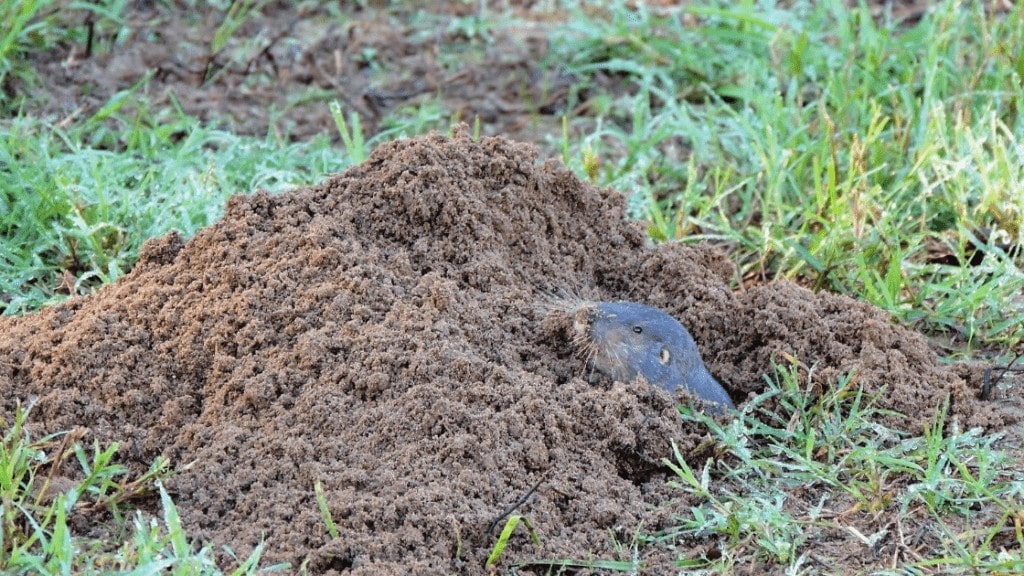
When gophers build tunnels, they need to discard the excess soil. This discarded soil accumulates above the ground and results in the formation of gopher mounds.
The crescent or horseshoe-shaped mounds in your garden or yard typically indicate that the gopher has finished excavating in that area and has plugged the exit. If a mound appears to be fan-shaped it means that the mound formation is not yet over and the gofer is still busy removing dirt.
A pest control expert will find it easier to capture the gopher and remove it when it is still removing excess soil from the excavated area. The same stands true even if you are trying to remove the rodent yourself.
Gophers are known for their overcautious nature. When confronted, these creatures will take little time to withdraw themselves inside a tunnel. While fleeing, they will forget to plug the exit hole of the mound. This will allow you (or the professional hired by you) to set the mechanical trap seamlessly. When the gopher will return for plugging the hole, the trap will catch it.
You can also use inactive yet fresh mounds for catching gophers. In that case, you will have to first reopen the mound’s exit hole and dig further to expose the tunnel.
2. What type of damage do they do?

The front teeth of gophers keep growing as long as they live, which forces them to gnaw constantly. Their habit of chiseling and chewing on underground equipment and plants allows them to stop their incisors from reaching an unmanageable size. The same habit is also responsible for causing damage to humans. Find out what kind of damages a gopher can cause.
Destroy gardens and crops: A gopher can cause serious damage to the plants, vegetables, and fruits in your garden in very little time. The more will be the number of gophers the greater would be the extent of damage your garden will suffer from.
Damage agricultural equipment: When tilling up soil for building tunnels, gophers often end up breaking or damaging parts of various farming equipment.
Break up underground pipes and utilities: Gophers might gnaw on sprinkler systems, plastic water pipes, and utility cables to stop their incisors from growing further. The worst thing about such damages is that they are not spotted until they cause any major issues.
3. Are there safety issues?
Gophers are mammals and thus are known for carrying rabies. It’s true that these rodents never exhibit any symptom of the infection but can pass it on to you or any other member of your family through bites.
The risk of infection becomes even greater if you have kids in your house. Your little ones may try to bring out a gopher from its hole and get bitten by it.
What’s even worse is that a property infested by gophers can put you at risk of having a series of other major illnesses besides rabies. These include monkeypox, hantavirus, and plague.
Methods of getting rid of Gophers
The above dangers linked to gopher infestation must have helped you to understand how important it is to get rid of these rodents. The section below would inform you about the most effective ways of removing these detrimental creatures from your yard.
1. Traps
Unless you are absolutely unlucky, you will not have more than one gopher in your yard. So, you shouldn’t find it difficult to set a mechanical trap, capture the animal, and then release it at a faraway place. Here, it must be noted that when using traps for catching gophers, you must take some preventive measures too for keeping gophers away. That’s because this method will neither repel nor kill the animal.
It shouldn’t be difficult for you to find a gopher trap in nearby stores or on ecommerce websites. If you have a rodent trap that fits the size of a gopher, it should also serve your purpose well. Measuring the diameter of a burrow hole in your yard should give you an idea about the size of the rodent you are looking to get rid of.
Steps of using live gopher traps:
Step 1: Read through the instructions on the packaging carefully to comprehend the working procedure of the trap. This should also help you to understand the right way of setting the trap up.
Step 2: Live traps usually feature a one-way door that snap shuts the moment it’s triggered. So, while setting the trap following the instructions, you should be extra cautious about not triggering the door before taking your fingers out.
You must be particularly careful when working with a trap equipped with spring mechanism.
Step 3: Now, you will have to bait the gopher trap using plant roots, vegetables, or fruits.
Step 4: Once the trap is ready, place it at the unplugged exit hole of a gopher mound and if the hole is plugged, dig some soil out and place the trap inside the tunnel.
Don’t forget to disguise the trap by covering it up with soil and dirt. Also, never commit the mistake of exposing the tunnel to sunlight.
Step 5: Keep checking the trap once every day to find out whether the gopher is caught.
Or if you want to euthanize the gophers, there are traps designed to swiftly exterminate them. Such traps grab the gopher till it expires on the trap. Amazon has a few good traps by clicking here: Gopher Traps
2. Chemicals
We would not recommend this method if you have kids or pets in your home. That’s because this method might put their lives at risk.
Here are a few things you must keep in mind when using chemicals or poisons for removing gophers. ****Always use the proper precautions****
- Read through the instructions that accompany the store-bought chemicals formulated for killing gophers.
- You should never forget to wear cloth or rubber gloves when handling these harmful chemicals.
- Abide by the instructions and place adequate amount of the chemical-based poison at the exit of a few gopher burrows in your yard.
- These poisons are usually made using strychnine or zinc phosphide. They result in neurological and psychological reactions in every living being coming in contact with them. That’s the reason why we are discouraging use of these chemicals in homes with pets and children.
- To encourage gophers to eat the chemicals, you can combine the poison with any bait ingredient of your choice.
- Keep a close eye on your yard and look for signs indicating that the gopher is no more active. If you fail to notice any remarkable change, reapply the poison.
- As gophers die when they are underground, you will not need to handle their carcass. However, once you know that the poison has done its job, you should not forget to seal the burrows.
3. Other methods
Use a detonators or burrow blaster: The other name used for this tool is gopher flare. A gopher flare works by filling the tunnels with oxygen and propane. This gas mix kills the rodents almost instantly.
Granule and liquid repellents: You can use the regular rodent repellents available in your nearby stores for turning gophers off. These products are typically made by blending castor oil, a few drops of predator urine, and certain chemicals.
The granules or liquid spray can be spread on the plants in your yard for stopping the gophers from chewing on them. You can also sprinkle/spray the repellent directly into the burrows.
4. Humane Methods
Out of the methods discussed above, using a live trap for catching the animal is the most humane one. If you don’t want to kill or harm the rodent, you can also try the methods below:
Make the environment noisy: Like most animals, gophers are also not very fond of loud noise. If you want to remove gophers from your garden or yard, use something that would make the environment noisy.
You can use a portable radio. If you don’t have one already in your home, buy a battery-operated unit. They are usually quite cheap.
Turn the radio on and pack it in a resealable, plastic bag. Place the bag inside a gopher tunnel. This should cause serious discomfort for the gopher and it will soon leave your yard.
Using the plastic bad is important for protecting the radio against the moisture and dirt inside the tunnel.
Use gopher spurge: Planting gopher spurge or Euphorbia lathyris around the gopher infested parts of your yard may help you in removing the rodent without killing it. Some other plants that can work as gopher repellent are marigolds, daffodils, and castor beans.
Which is more effective?
If you want to stick to humane methods, setting a trap to catching gopher is the most effective way of getting rid of the rodent. However, if you want to remove the creature permanently, poisoning them is the most effective option. If you are still confused, get in touch with a pest control technician. He will guide you on the efficacy of various methods.
Are there ways of discouraging gophers?
If you don’t take necessary steps for discouraging gophers from entering your yard, you will see the problem come back and cause even more serious damage to your property. Here are a few things you can do to prevent gopher infestations.
Install physical barriers: Here are the options you may try:
- Fencing: A regular privacy fence will not be able to stop gophers from entering your premises. You will have to install hardware cloth or wire mesh perimeter fences for keeping these rodents out. However, for these fences to do the job for you, you will have to extend them at least a food beneath the ground.
- Mulch: Mulch around the plants in your garden for preventing the gophers from eating their heads or pulling them downwards.
Raise the plant beds: By raising plant beds, you will be offering the plants in your garden the required room for growing and also reduce their risk of encountering gopher invasions. For more information about raised garden beds, we have an excellent article by clicking here.
Introduce natural predators: You can allow your household pets (a cat or a dog) to chase the gophers off. However, while doing so don’t forget to monitor your pets as gophers can infect them with ticks, fleas, and diseases.
Conclusion
The above discussion should allow you to manage gopher problems without any professional help. However, if you want a more permanent solution to the issue or don’t have enough time to follow all the advices provided in this article, it would be a good idea to seek professional help.
